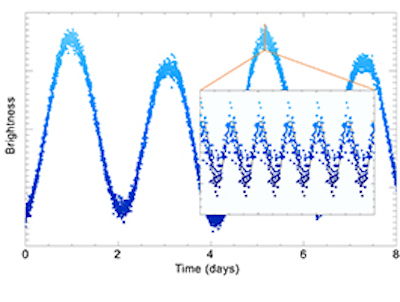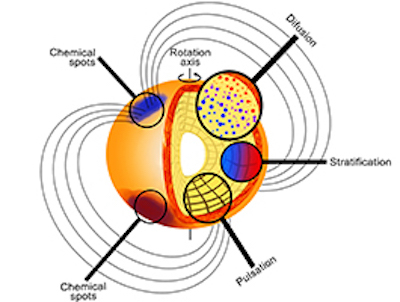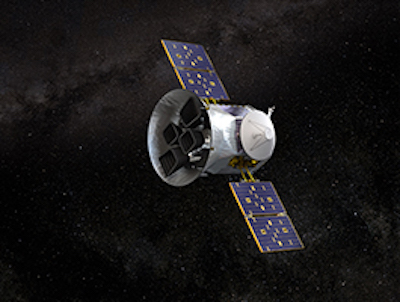17.06.2019

Brightness variation of the roAp star TIC 237336864 as observed by the TESS satellite. The light from the star is seen to vary on two characteristic time scales. Credit: Daniel Holdsworth (Jeremiah Horrocks Institute, U. of Central Lancashire)
Using asteroseismic1 techniques, an international team2 searched for pulsations in a subsample of five thousand stars, from the 32 thousand observed in short cadence in the first two sectors (roughly the first two months of science operations) of NASA‘s Transiting Exoplanet Survey Satellite (TESS), and found five rare rapidly oscillating Ap (roAp3) stars. These results4 were accepted for publication in the journal Monthly Notices of the Royal Astronomical Society.
Among the stellar data, the team found the fastest known roAp pulsator, which completes one pulsation every 4.7 minutes. Two of these five stars were found to be particularly challenging to the currently understanding of the field, one because it is cooler than theoretically expected for a roAp star and the other because it exhibits pulsation frequencies that are unexpectedly high.
First author Margarida Cunha (Instituto de Astrofísica e Ciências do Espaço - IA5 & Universidade do Porto), explains the importance of studying these stars: “The TESS data shows that less than 1% of all A-type stars are likely to be rapidly oscillating Ap stars. Yet, the discovery of these rare pulsators can contribute greatly to the correct modelling of stellar evolution, because roAp stars are unique testbeds for the modelling of the physical processes responsible for chemical element segregation, such as atomic diffusion and radiative levitation.”
Following an in-depth analysis of 80 stars previously known to be chemically peculiar, the team also found 27 new rotational Ap variables, and derived their rotation periods, based on brightness changes during the star’s rotation, produced by passing chemical spots.
To Daniel Holdsworth, from the Jeremiah Horrocks Institute of the University of Central Lancashire), these TESS observations: “are allowing us to study this rare type of pulsating star in a homogeneous way. This allows us to compare one star to another without having to treat the data in a special way. Furthermore, the full-sky nature of the TESS observations will enable us to discover many new roAp stars, and Ap stars which do not pulsate, allowing us to test and refine start-of-the-art theoretical models of pulsations in Ap stars.”

Artist's impression of a rapidly oscillating Ap star (roAp), highlighting its complexity. The diversity of physical phenomena taking place in their outer layers, makes roAp stars ideal testbeds to the modelling of stellar physics. Credit: Victoria Antoci (Stellar Astrophysics Centre, Aarhus University)

Artists impression of NASA's Transiting Exoplanet Survey Satellite (TESS). Credit: NASA's Goddard Space Flight Center
For seven roAp stars, previously known from ground-based observations, high-precision photometric data was also gathered. For four of these stars, it was possible to set constraints on the star’s inclination angle6 and magnetic obliquity7. Margarida Cunha, a member of the steering committee of the TESS Asteroseismic Science Consortium (TASC) adds: “The correct modelling of these physical processes is amongst the most challenging goals faced in stellar evolution research. The discovery of new roAp stars by TESS, as well as the exquisite new data the satellite is providing on roAp stars previously discovered from the ground, will be key to achieving this goal.”
Victoria Antoci, from the Stellar Astrophysics Centre at Aarhus University, explains: “It is exciting that we now have more bright roAp and Ap stars that we can follow-up from ground with small and middle-sized telescopes, which are easier to access. To fully understand the physis in these stars, It is important not only to measure their light variations but also to determine their magnetic field as well as the chemical composition in their outer atmospheres. These stars have very strong magnetic fields, up to 25 kiloGauss. This is about 250 times stronger than a fridge magnet that is of the order of 100 Gauss.”
These new results were only made possible because the TESS satellite is continuously observing the stars for periods of at least 27 days, outside the interference of the Earth's atmosphere, something ground-based observatories cannot achieve.
Notes
- Asteroseismology is the study of stellar interiors, by measuring seismic oscillations at the star’s surface. In seismology, the different vibration modes from an Earthquake can be used to study the Earth’s interior, in order to get data from the composition and depth of its different layers. In a similar fashion, oscillations at the star’s surface can be used to infer the internal structure and composition of a star.
- The team is: M. S. Cunha (Instituto de Astrofísica e Ciências do Espaço & Universidade do Porto); V. Antoci (Stellar Astrophysics Centre, Aarhus University); D. L. Holdsworth, D. W. Kurtz (Jeremiah Horrocks Institute, University of Central Lancashire); L. A. Balona (South African Astronomical Observatory); Zs. Bognár (Konkoly Observatory, MTA CSFK Lendület Near-Field Cosmology Research Group); D. M. Bowman (Institute of Astronomy, KU Leuven); Z. Guo (Center for Exoplanets and Habitable Worlds, 525 Davey Laboratory, The Pennsylvania State University & Copernicus Astronomical Center, Polish Academy of Sciences); P. A. Kołaczek-Szymański (Astronomical Institute of University of Wrocław); M. Lares-Martiz (Instituto de Astrofísica de Andalucía (CSIC)); E. Paunzen (Department of Theoretical Physics and Astrophysics, Masaryk University); M. Skarka (Department of Theoretical Physics and Astrophysics, Masaryk University & Astronomical Institute, Czech Academy of Sciences); B. Smalley (Astrophysics Group, Keele University); Á . Sódor (Konkoly Observatory & MTA CSFK Lendület Near-Field Cosmology Research Group); O. Kochukhov (Department of Physics and Astronomy, Uppsala University); J. Pepper (Department of Physics, Lehigh University); T. Richey-Yowell (School of Earth and Space Exploration, Arizona State University); G. R. Ricker (Department of Physics & Kavli Institute for Astrophysics and Space Research, Massachusetts Institute of Technology); S. Seager (Department of Physics & Earth and Planetary Sciences, Massachusetts Institute of Technology); D. L. Buzasi (Department of Chemistry and Physics, Florida Gulf Coast University); L. Fox-Machado (Instituto de Astronomía–Universidad Nacional Autónoma de México); A. Hasanzadeh (Department of Physics, University of Zanjan); E. Niemczura (Astronomical Institute of University of Wrocław); P. Quitral-Manosalva, M. J. Monteiro (Instituto de Astrofísica e Ciências do Espaço & Faculdade de Ciências da Universidade do Porto); I. Stateva (Institute of Astronomy and NAO, Bulgarian Academy of Sciences); P. De Cat (Royal Observatory of Belgium); A. García Hernández (Dept. Física Teórica y del Cosmos, Universidad de Granada); H. Ghasemi (Department of Physics, Institute for Advanced Studies in Basic Sciences (IASBS)); G. Handler (Copernicus Astronomical Center, Polish Academy of Sciences); D. Hey (Stellar Astrophysics Centre, Aarhus University & Sydney Institute for Astronomy, School of Physics, University of Sydney); J. M. Matthews (Department of Physic & Astronomy, University of British Columbia); J. M. Nemec (Department of Physics and Astronomy, Camosun College); J. Pascual-Granado (Instituto de Astrofísica de Andalucía (CSIC)); H. Safari (Department of Physics, University of Zanjan); J. C. Suárez (Instituto de Astrofísica de Andalucía (CSIC) & Dept. Física Teórica y del Cosmos, Universidad de Granada); R. Szabó (Konkoly Observatory & Lendület Near-Field Cosmology Research Group, MTA CSFK); A. Tkachenko (Institute of Astronomy, KU Leuven) and W. W. Weiss (Department of Astrophysics, University of Vienna).
- Rapidly oscillating Ap stars, also known as roAp stars, are rare stellar objects. They are found among the chemically peculiar Ap stars, which are characterised by surface spots with enhanced abundances of Si, Cr, Sr, or Eu, up to a million times the solar value. Ap stars have strong magnetic fields and a small fraction exhibits low amplitude pulsations, at frequencies similar to those seen in our sun.
- The article “Rotation and pulsation in Ap stars: first light results from TESS sectors 1 and 2” was accepted for publication in the journal Monthly Notices of the Royal Astronomical Society and is available on arXiv.
- O Instituto de Astrofísica e Ciências do Espaço (IA) é a maior unidade de investigação na área das Ciências do Espaço em Portugal, integrando investigadores da Universidade do Porto e da Universidade de Lisboa, e englobando a maioria da produção científica nacional na área. Foi avaliado como “Excelente” na última avaliação que a Fundação para a Ciência e Tecnologia (FCT) encomendou à European Science Foundation (ESF). A atividade do IA é financiada por fundos nacionais e internacionais, incluindo pela FCT/MCES (UID/FIS/04434/2019).
- The stellar inclination angle is the angle between the star's rotation axis and the direction of the observer.
- The magnetic obliquity is the angle between the rotation and magnetic axes in a star.
Quelle: ia Institute of Astrophysics and Space Sciences
